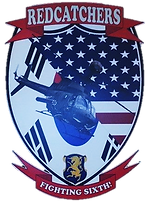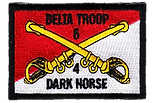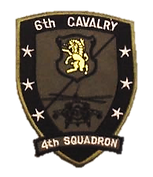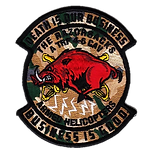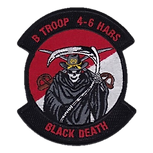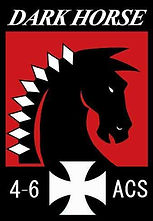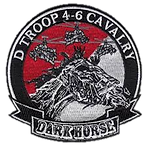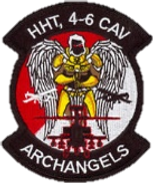
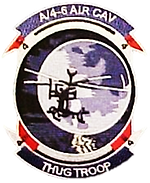
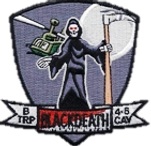
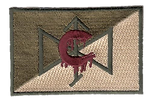
4th Squadron, 6th Cavalry
Redcatchers
Joint Base Lewis McChord, Washington
(2005 - Present)
In early 2005 it was announced that the 3d Armored Cavalry Regiment (3 ACR) stationed at Fort Carson, Colorado, would be inactivated. With this inactivation, 4-2 AVN (a subordinate aviation battalion) was reflagged as 4th Squadron, 6th Cavalry (4-6 CAV), and transferred to Fort Lewis, Washington.
In Spring 2006, the squadron deployed to the National Training Center (NTC), Mohave Desert, California, in preparation for its upcoming deployment to Iraq. However, by the time the squadron would leave, a year had passed and it was decided that the squadron needed another training exercise before deployment. However, 4-6 CAV had grown to over 850 troopers, and it would be a logistical nightmare to move this soon before deployment, so the Army brought the exercise to 4-6 CAV, with elements from the Joint Readiness Training Center (JRTC), at Fort Polk, Louisiana, deploying to Fort Lewis, Washington. After the seven-day exercise, the squadron's aircraft were flown to Grays Harbor, where they were loaded on a ship bound for Kuwait. Due to mob crowds of protestors at the harbor, the squadron had to change the date of departure, which was a success.
On 7 June 2007, the squadron, now organized as Task Force Redcatcher, deployed for 15-months to Iraq during the troop surge, in support of Operation IRAQI FREEDOM 07-09. First stationed in Kuwait, 4-6 CAV flew across the berm and into Iraq on 28 June 2007, whereupon it was stationed at Tal Afar, with two-week team rotations to Mosul. The squadron received participation credit for the IRAQI SURGE campaign.
On 30 January 2008, a Scout Weapons Team (SWT) consisting of 2x OH-58Ds began its daily aerial patrol. A few minutes into the shift, the team was called to another area of Mosul to attack an insurgent van carrying a heavy-caliber machine gun. Each Kiowa fired a Hellfire missile and both missiles hit their target and destroyed the vehicle. The SWT then began to take heavy enemy gunfire, whereupon the team lowered the aircraft behind a nearby hill, directly over a cemetery and prepared to return to the source of the gunfire and engage the enemy. The aircraft climbed a hard 1500 feet, crested the hill and returned to the source of gunfire where it received extremely heavy fire. It engaged back with a .50 caliber machine gun, then banked left to leave, when the enemy returned more fire.
This time the enemy gunfire succeeded in disabling the aircraft. A bullet struck the bar which holds the aircraft's cyclic controls, knocking out electricity in part of the helicopter and taking out all its communications abilities. The pilots prepared to land the helicopter, but luckily, the engine did not quit. Without any communication with the other helicopter or a controller, DiGiorgio and Sickler lowered the aircraft close to the ground and navigated their way back to base by watching the Mosul city roads beneath them. Upon their return, Lt. Sickler jumped out and ran down to an alternate helicopter, then departed and met up with the second aircraft. The two helicopters returned to the scene where they engaged another enemy vehicle with Hellfire missiles, destroying it and killing the insurgents who'd previously fired on them. The Kiowas were then called onto an alternate mission before returning once more to the scene near the cemetery and spent the rest of the day tracking the one insurgent who escaped. The other nine enemy fighters were either killed or wounded in the firefight. For their gallant actions, CPT Peter DeGiorgio and LT Robert Sickler received the Distinguished Flying Cross, and Chief Warrant Officers Thomas Boise and Susan Weathers received the Air Medal for Valor.
In mid-2008, 4-6 CAV redeployed to Fort Lewis. The return marked the last air cavalry squadron and OH-58D Kiowa Warrior helicopters deployed to Iraq.
In October 2012, 4-6 CAV conducted Aerial gunnery at Yakima Training Center.
On 12 September 2013, the squadron cased its colors and soon after deployed to South Korea as part of a Rotation of Forces plan in conjunction with the 2nd Infantry Division based at Camp Humphreys. The squadron became the first regionally aligned force to Korea and conducted reconnaissance missions while attached to the 2nd Combat Aviation Brigade. Upon completion of the nine-month rotation, the squadron returned to JBLM and uncased its colors on 30 June 2014 and inactivated on 15 August 2014. Squadron members were recognized on 25 August 2014 by the Bell Helicopter company for achievements in maintenance and combat hours.
On 17 June 2015, 4-6 CAV was activated from the reflagged 1-25 Heavy Attack Reconnaissance Squadron, at Fort Carson, Colorado. Outfitted with AH-64 Apaches, the squadron transferred to JBLM, Washington.
On 20 October 2015, the squadron completed its inaugural flight of the Shadow Unmanned Aerial System at Yakima Training Center, Washington. Subsequently, 4-6 CAV became the first heavy attack reconnaissance squadron integrating unmanned aerial systems into AH-64E operations.
2016 proved to be a busy year for the squadron. On 6 January 2016, four AH-64E Guardians assigned to the squadron departed JBPHH and flew in formation, which arrived at WAAF. Their six-month mission was to train with 2-6 CAV and simultaneously support the 25th Infantry Division during the upcoming exercise LIGHTNING FORGE 17-01. 2016 Operations also included two National Training Center (NTC) rotations, Exercise RAPTOR FURY, in Idaho, and multiple training events in Yakima Training Center.
From 3 December 2016 to 31 August 2017, the squadron deployed as Task Force Saber in support of Operation INHERENT RESOLVE.
